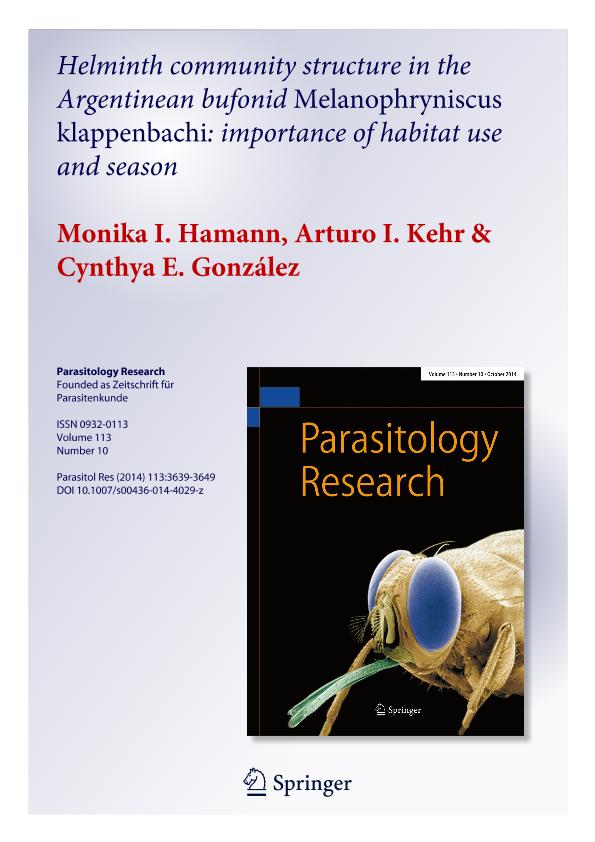Mostrar el registro sencillo del ítem
dc.contributor.author
Hamann, Mónika Inés

dc.contributor.author
Kehr, Arturo Ignacio

dc.contributor.author
Gonzalez, Cynthya Elizabeth

dc.date.available
2017-10-02T14:03:43Z
dc.date.issued
2014-07
dc.identifier.citation
Hamann, Mónika Inés; Kehr, Arturo Ignacio; Gonzalez, Cynthya Elizabeth; Helminth community structure in the Argentinean bufonid melanophryniscus klappenbachi: importance of habitat use and season; Springer; Parasitology Research; 113; 10; 7-2014; 3639-3649
dc.identifier.issn
0932-0113
dc.identifier.uri
http://hdl.handle.net/11336/25542
dc.description.abstract
The goal of this study was to evaluate the relative influence of terrestrial habits, season, and host body size on the species richness and abundance of helminth parasites in the toad Melanophryniscus klappenbachi, for which a greater abundance of nematode parasites was expected. A total of 90 toads were collected in the Chaco Province, Argentina. The helminth community found in infected toads included 17 taxa and was dominated particularly by larval parasites. Contrary to our expectations, nematode species showed lower values of infection parameters. Infected toads harbored a maximum of seven species, and the mean helminth richness was 3.16±1.66 species per infected toads. Season played a significant effect on determining the species richness and abundance of the parasite infracommunity. Similarly, the prevalence of infection of several helminth species (8/47 %) varied greatly over time. Host body size was the main factor in determining the infrapopulation structure of helminth parasites. Species richness was significantly and negatively correlated with host body size. Strong associations were observed mainly between larvae of some species. The transmission strategies of parasites suggest that this bufonid acquires infections through direct contact with larval parasites from aquatic and terrestrial habitats and by ingestion of infective larvae. The characteristic of the host tegument, such as the presence of alkaloids, could significantly contribute to the low occurrence of infection by skin-penetrating nematodes. Results also showed that diets and mobility of the host and the local microhabitat conditions play an important role in parasitic infections of toads.
dc.format
application/pdf
dc.language.iso
eng
dc.publisher
Springer

dc.rights
info:eu-repo/semantics/openAccess
dc.rights.uri
https://creativecommons.org/licenses/by-nc-sa/2.5/ar/
dc.subject
Helminth Community
dc.subject
Season
dc.subject
Habitat Use
dc.subject
Melanophryniscus Klappenbachi
dc.subject
Chaco Province
dc.subject.classification
Bioquímica y Biología Molecular

dc.subject.classification
Ciencias Biológicas

dc.subject.classification
CIENCIAS NATURALES Y EXACTAS

dc.title
Helminth community structure in the Argentinean bufonid melanophryniscus klappenbachi: importance of habitat use and season
dc.type
info:eu-repo/semantics/article
dc.type
info:ar-repo/semantics/artículo
dc.type
info:eu-repo/semantics/publishedVersion
dc.date.updated
2017-09-19T18:23:33Z
dc.identifier.eissn
1432-1955
dc.journal.volume
113
dc.journal.number
10
dc.journal.pagination
3639-3649
dc.journal.pais
Alemania

dc.journal.ciudad
Berlin
dc.description.fil
Fil: Hamann, Mónika Inés. Consejo Nacional de Investigaciones Científicas y Técnicas. Centro Científico Tecnológico Conicet - Nordeste. Centro de Ecología Aplicada del Litoral. Universidad Nacional del Nordeste. Centro de Ecología Aplicada del Litoral; Argentina
dc.description.fil
Fil: Kehr, Arturo Ignacio. Consejo Nacional de Investigaciones Científicas y Técnicas. Centro Científico Tecnológico Conicet - Nordeste. Centro de Ecología Aplicada del Litoral. Universidad Nacional del Nordeste. Centro de Ecología Aplicada del Litoral; Argentina
dc.description.fil
Fil: Gonzalez, Cynthya Elizabeth. Consejo Nacional de Investigaciones Científicas y Técnicas. Centro Científico Tecnológico Conicet - Nordeste. Centro de Ecología Aplicada del Litoral. Universidad Nacional del Nordeste. Centro de Ecología Aplicada del Litoral; Argentina
dc.journal.title
Parasitology Research

dc.relation.alternativeid
info:eu-repo/semantics/altIdentifier/doi/http://dx.doi.org/10.1007/s00436-014-4029-z
dc.relation.alternativeid
info:eu-repo/semantics/altIdentifier/url/https://link.springer.com/article/10.1007/s00436-014-4029-z
Archivos asociados
